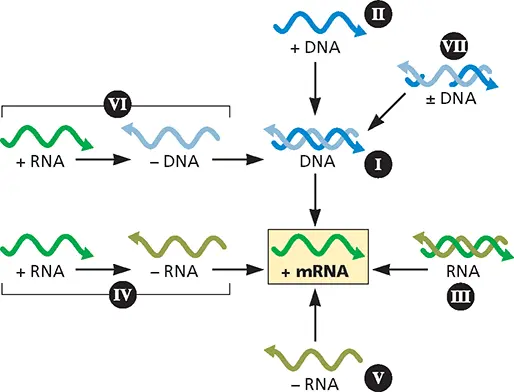Jane Flint - Principles of Virology
Здесь есть возможность читать онлайн «Jane Flint - Principles of Virology» — ознакомительный отрывок электронной книги совершенно бесплатно, а после прочтения отрывка купить полную версию. В некоторых случаях можно слушать аудио, скачать через торрент в формате fb2 и присутствует краткое содержание. Жанр: unrecognised, на английском языке. Описание произведения, (предисловие) а так же отзывы посетителей доступны на портале библиотеки ЛибКат.
- Название:Principles of Virology
- Автор:
- Жанр:
- Год:неизвестен
- ISBN:нет данных
- Рейтинг книги:3 / 5. Голосов: 1
-
Избранное:Добавить в избранное
- Отзывы:
-
Ваша оценка:
- 60
- 1
- 2
- 3
- 4
- 5
Principles of Virology: краткое содержание, описание и аннотация
Предлагаем к чтению аннотацию, описание, краткое содержание или предисловие (зависит от того, что написал сам автор книги «Principles of Virology»). Если вы не нашли необходимую информацию о книге — напишите в комментариях, мы постараемся отыскать её.
Volume I: Molecular Biology
Volume II: Pathogenesis and Control
Principles of Virology, Fifth Edition
Principles of Virology — читать онлайн ознакомительный отрывок
Ниже представлен текст книги, разбитый по страницам. Система сохранения места последней прочитанной страницы, позволяет с удобством читать онлайн бесплатно книгу «Principles of Virology», без необходимости каждый раз заново искать на чём Вы остановились. Поставьте закладку, и сможете в любой момент перейти на страницу, на которой закончили чтение.
Интервал:
Закладка:
The International Committee on Taxonomy of Viruses (ICTV), founded by André Lwoff, authorizes and organizes the classification and establishes nomenclature for all viruses. Freely available as a periodically updated, online resource ( https://ictv.global/taxonomy), the 2018 report lists orders, families, genera, and species for all known viruses. In addition, it describes numerous viruses that are not yet classified and probably representatives of new genera and/ or families. The ICTV catalog also includes descriptions of subviral agents ( satellites, viroids, and prions) and a list of viruses for which information is still insufficient to make assignments. The pace of discovery of new viruses has been accelerated greatly with the application of metagenomic analyses, direct sequencing of genomes from environmental samples, suggesting that we have barely begun to chart the viral universe.
The ICTV nomenclature has been applied widely in both the scientific and medical literature, and therefore we adopt it in this text. In this nomenclature, the Latinized virus family names are recognized as starting with capital letters and ending with -viridae , as, for example, in the family name Parvo-viridae . These names are used interchangeably with their common derivatives, as, for example, parvoviruses (see additional examples in the Appendix).
Classification by Genome Type: the Baltimore System
Francis Crick conceptualized the central dogma for flow of information from the DNA genome in all living cells:
DNA → mRNA → protein
As intracellular parasites that depend on the host cell’s translational machinery for protein production, all viruses must direct the synthesis of mRNAs. But viral genomes comprise both DNA and RNA in a variety of conformations. Appreciation of the essential role of the translational machinery in virus reproduction inspired David Baltimore, in 1971, to devise a classification scheme for viruses, based on the steps that would be required to produce mRNA from their diverse genomes ( Fig. 1.12).
BOX 1.10
DISCUSSION
Giant viruses discovered in amoebae
The mimivirus virion, the prototype member of the Mimiviridae , was the first giant virus of amoebae to be discovered. Isolated from water in a cooling tower in England in 1992, it is large enough to be visible in a light microscope and was initially thought to be an intracellular bacterium within its host. Not until publication of a brief note in 2003 did it become apparent that this giant was really a virus. The mimivirus genome of 1.2 Mbp was much larger than that of any known virus at the time, exceeding that of some bacteria. This giant encodes more than 900 proteins, many of which are components of the protein translational apparatus, a function for which other viruses rely entirely on the host.
Since reports of the first giant viruses, the use of different strains of amoebae to screen soil and water samples from diverse environments and geographic locations has yielded more than 50 isolates, assigned to nine distinct families. Among the most spectacular is a Pandoravirus isolate, discovered in saltwater off the coast of Chile in 2013. The genome of this giant is twice the size of the mimivirus genome, and contains ∼2,500 putative protein-coding sequences, most of them never seen before. Furthermore, while mimivirus has a more or less familiar icosahedral capsid, the Pandoravirus has no regular capsid. Instead, the genomes of these viruses are surrounded by an ovoid envelope, with a pore at the apex that allows delivery of the internal components into the cytoplasm of its host. The following year two additional giant amoeba viruses, a circular mollivirus and ovoid pithovirus, were discovered in a sample of Siberian permafrost more than 30,000 years old.
The unusual properties of the giant viruses of amoebae have prompted the somewhat controversial speculation that they might represent a separate branch in the tree of life, or that they arose by reductive evolution from the nucleus of a primitive cellular life form. However, the discovery in 2017 of another group of these viruses, by metagenomic analysis of samples from a sewer in Klosterneuburg, Austria, has suggested a more pedestrian origin. While the new group, called Klosneuviruses, encode numerous components of translational machinery, comprehensive phylogenetic analyses indicate that these genes were captured from a cellular host by a smaller, precursor virus during evolution of Klosneuviruses. If this is a general phenomenon, the 2018 description of tailed mimivirus relatives, isolated from the extreme environments of an alkaline soda lake in Brazil and from deep in the Atlantic Ocean, must be considered an extraordinary example of such capture. The genomes of these odd-looking isolates, called Tupanviruses, contain nearly all of the necessary translation-associated genes, lacking only ribosomes for protein synthesis. It would seem that there is still much to ponder concerning the evolution of these giant viruses.

Properties of some of the largest currently known giants, all of which infect amoebae, with representative vertebrate-infecting DNA viruses, of which poxviruses are the largest.The broad range of nucleic acid composition among the amoeba viral genomes is illustrated by the substantial differences in their G+C content. The number of known or putative coding genes in each viral genome is listed. Examples of small, medium, and large mammalian viruses (poliovirus, herpesvirus, and vaccinia virus, respectively) are included for comparison.
For illustrations of giant amoeba virus structures, see http://viralzone.expasy.org/all_by_species/670.html. See also TWiV 261: Giants among viruses. Interview with Drs. Chantal Abergel and Jean-Michel Claverie at http://www.microbe.tv/twiv/twiv-261-giants -among-viruses/.
Abrahão J, Silva L, Silva LS, Khalil JYB, Rodrigues R, Arantes T, Assis F, Boratto P, Andrade M, Kroon EG, Ribeiro B, Bergier I, Seligmann H, Ghigo E, Colson P, Levasseur A, Kroemer G, Raoult D, La Scola B. 2018. Tailed giant Tupanvirus possesses the most complete translational apparatus of the known virosphere. Nat Commun 9:749–761.
Colson P, La Scola B, Levasseur A, Caetano-Anollés G, Raoult D. 2017. Mimivirus: leading the way in the discovery of giant viruses of amoebae. Nat Rev Microbiol 15:243–254.
Colson P, La Scola B, Raoult D. 2017. Giant viruses of amoebae: a journey through innovative research and paradigm changes. Annu Rev Virol 4:61–85.
Racaniello V. 8 March 2018. Only the ribosome is lacking. Virology Blog. http://www.virology.ws/2018/03/08/only-the-ribosome-is-lacking/.
Schulz F, Yutin N, Ivanova NN, Ortega DR, Lee TK, Vierheilig J, Daims H, Horn M, Wagner M, Jensen GJ, Kyrpides NC, Koonin EV, Woyke T. 2017. Giant viruses with an expanded complement of translation system components. Science 356:82–85.

Figure 1.12 The Baltimore classification. The Baltimore classification assigns viruses to seven (I to VII) distinct classes on the basis of the nature and polarity of their genomes. Because all viruses must produce mRNA that can be translated by cellular ribosomes, knowledge of the composition of a viral genome provides insight into the pathways required to produce mRNA, indicated by arrows. See also Baltimore D. 1971. Bacteriol Rev 35:235–241.
Читать дальшеИнтервал:
Закладка:
Похожие книги на «Principles of Virology»
Представляем Вашему вниманию похожие книги на «Principles of Virology» списком для выбора. Мы отобрали схожую по названию и смыслу литературу в надежде предоставить читателям больше вариантов отыскать новые, интересные, ещё непрочитанные произведения.
Обсуждение, отзывы о книге «Principles of Virology» и просто собственные мнения читателей. Оставьте ваши комментарии, напишите, что Вы думаете о произведении, его смысле или главных героях. Укажите что конкретно понравилось, а что нет, и почему Вы так считаете.











